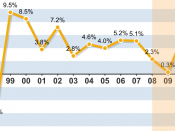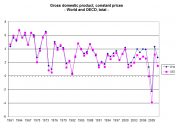Australia's economic performance in the latter half of the 1990s to the present day has been highly competitive against the industrialised OECD nations of the world. Indeed, although constrained by a recession in the early 1990s, Australia's performance until recently has been a period of relatively strong economic growth.
In terms of percentage annual change in the volume of real GDP, Australia emerged from the 1990s to consistently uphold economic growth for almost a decade, only to experience its first contraction in late 2000. Having recorded growth exceeding 4%pa prior to the year 1995, Australia continued to sustain growth from 1995-97, albeit to a slightly lesser extent. From 4.5% in 1995-96, growth fell to 3.8% in 1996-97, however still above the OECD 7's average of 3.2%. Australia's performance in the ensuing years is most remarkable considering that the Asian Crisis between 1997-99 saw most economies in the region experience recession in 1998.
Whilst other OECD nations experienced an average economic growth slowdown to 2.8%, Australia went on to record 3 consecutive years of growth above 4% between 1997-98 and 1999-00.
However, in the second half of 2000, as Australia entered the 10th year of its economic growth cycle, a dramatic slowdown occurred. Although the Government had predicted 4% growth in 2000-01, Australia instead recorded the first contraction in a decade, the last quarter of the year resulting in a 0.6% contraction. Growth is now expected to be 2% for 2001, however the government is still confident that the economic downturn will be short lived, predicting that economic growth will rise from 2% in 2000-01, to 3.25% in 2001-02. The figures in the past 6 years have been well above the nation's historical average of 3%pa in the 1970s and 80s. The uses of different government policies have contributed heavily towards...


